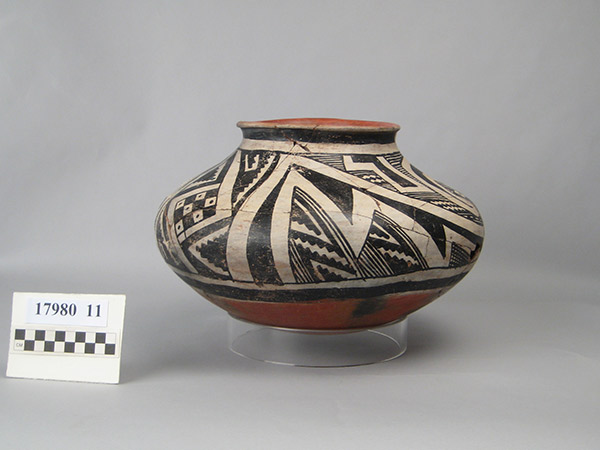Archaeological Pottery Project: IMLS Conservation Survey
1600 years of American Indian Pottery in New Mexico
Pottery is ubiquitous in New Mexico. We see it everywhere on the landscape, scattered over the ancestral Pueblo sites and in the villages today. The continuity of pottery is unbroken, from the earliest known examples in the Museum’s collections to the contemporary work of today; it is a living tradition. Pottery is the best record of human habitation in the Southwest—every group made it, and it does not disintegrate as do the more fragile materials such as baskets, wood, and textiles.
- Landis Smith, Conservator
- The Collection:
- The Museum’s collection of nearly 5000 whole archaeological ceramic vessels, together with 4500 historic and contemporary vessels manufactured during the 18th–21st centuries, form a continuous record of 1600 years of human habitation and indigenous pottery making in New Mexico. Together, they represent the most complete assemblage of indigenous New Mexico ceramics anywhere in the world. The archaeological, or, excavated collections, range from the earliest known Mogollon (AD 400) pots to pottery from the 1600s, after Spanish contact.
- Pottery as a resource:
- MIAC pottery collections are not simply warehoused. They are actively accessed for research, education, publications, and exhibition purposes by archaeologists, students, scholars, Native artists, museum curators, and educators. Pottery’s raw materials and manufacturing techniques offer insights about life in our region, including food preparation and storage, interaction and trade, and continuity and change in symbolic systems in the American Southwest. Importantly, the collections of Ancestral Pueblo pottery have offered artistic inspiration for contemporary Pueblo potters.
The Move to the Center for New Mexico Archaeology
 Current storage conditions for the pottery collection are overcrowded, fragmented and difficult to access for study and education. Therefore, the archaeological pottery will be moved to the new Center for New Mexico Archaeology (CNMA).
Current storage conditions for the pottery collection are overcrowded, fragmented and difficult to access for study and education. Therefore, the archaeological pottery will be moved to the new Center for New Mexico Archaeology (CNMA).
In order to safely move these important archaeological ceramics to the new facility, the pots must be in a condition to withstand handling, packing, transport, and then unpacking and re-storage at the new facility. In other words, the pots must be stable. Therefore the Museum Resources Division (MRD) Conservation Unit designed and implemented a survey of the entire collection in which each pot was assessed and prioritized in terms of conservation treatment needed.

